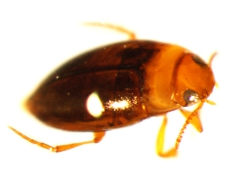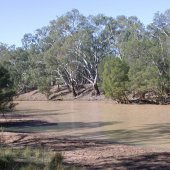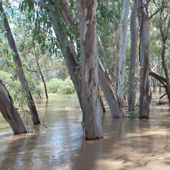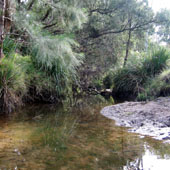|
|
Stream macroinvertebrate richness - a case studyMacroinvertebrates are invertebrates that are large enough to be seen with the naked eye. Some common macroinvertebrates found in wetlands include dragonfl, mayfly, and caddisfly nymphs, worms, snails, beetles, leeches, small crustaceans and other insects. Quick facts
Substrate composition and heterogeneity in streams[6]Diversity of local conditions has long been considered a primary influence on stream invertebrate richness[10]. The availability of different substrate types from hard (cobbles, boulders or bedrock) to soft (sand, silt or clay) is influenced by geology, hydrology, and topography. Many studies have identified substrate composition, complexity and heterogeneity as major determinants of in-stream biota[2][4][7][8][1]. For example, detailed studies of abiotic influences upon occurrence patterns of Ephemeroptera and Odonata species in Hong Kong streams found substrate composition and heterogeneity to be the strongest correlate with population sizes of almost all species and thus also with assemblage structure[3]. Further evidence of the importance of substrate is provided by studies demonstrating large changes in the faunal composition of streams subject to substrate modifications as a consequence of increased sedimentation[11][9]. Macroinvertebrate richnessIn a review of environmental factors influencing the biodiversity of stream insects, Vinson and Hawkins (1998) identified consistent empirical associations in which more complex substrate types support more taxa than structurally simple types such as sand or bedrock. As such, provinces dominated by fine silt and clay with little hard substrate availability (e.g. Murray-Darling) tend to have lower macroinvertebrate richness than those with high substrate heterogeneity (e.g. Central or Wet Tropics). In general, hard substrate classes (e.g. cobbles, boulders and bedrock) fulfil a number of ecological requirements for macroinvertebrate taxa. They function as shelter from predators, substrate for bio-film development, ambush points for predators, substrate for egg attachment, flood and drought refuge. In areas with low hard substrate availability their function can be replicated by large woody debris. Table: Results of Pearson’s correlations between substrate heterogeneity and number of substrate classes present with macroinvertebrate sample richness fromABMAP reference sites throughout Queensland.
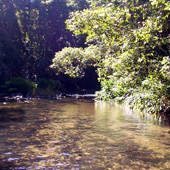  Bank shape and slopeBanks with low slopes and with steps or flat benches are likely to accumulate organic matter to a greater degree than steep banks. When inundated, the accumulated organic matter can provide habitat for biota and sources of energy to aquatic foodwebs. Bank slope also influences the benthic photic zone area in turbid systems. As light penetration is a function of water depth, shallow sloping areas (e.g. benches or steps) are likely to provide a greater area of benthic production than steep sloping banks. Inundated benches and under-cut areas represent important habitat for biota, for example young golden perch, Macquaria ambigua, use inundated vegetated benches and there is evidence recruitment is more successful in the presence of these features. Other species of fish, such as the eel-tailed catfish Tandanus tandanus, utilise under-cut banks as an important adult habitat. References
Last updated: 22 March 2013 This page should be cited as: Department of Environment, Science and Innovation, Queensland (2013) Stream macroinvertebrate richness - a case study, WetlandInfo website, accessed 8 May 2025. Available at: https://wetlandinfo.des.qld.gov.au/wetlands/assessment/monitoring/invertebrates/macroinvertebrates.html |
|||||||||||||||||||||||||

 — Department of the Environment, Tourism, Science and Innovation
— Department of the Environment, Tourism, Science and Innovation

